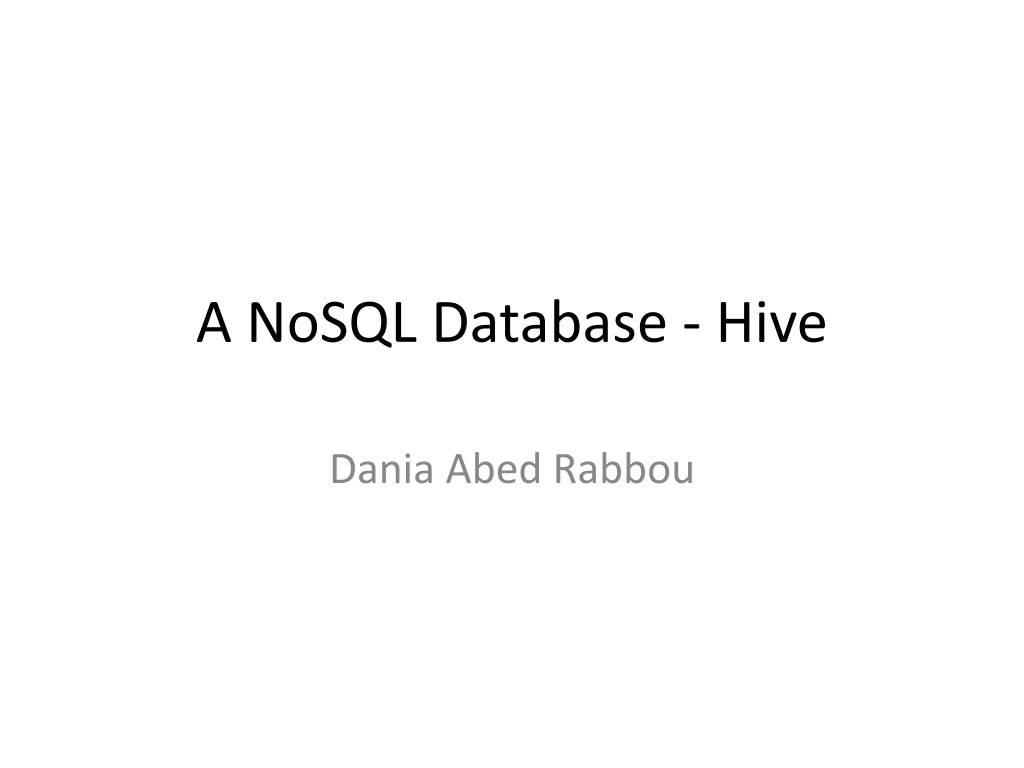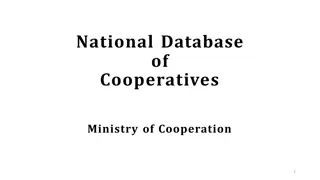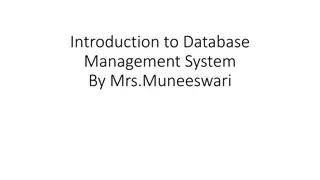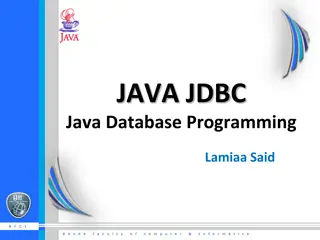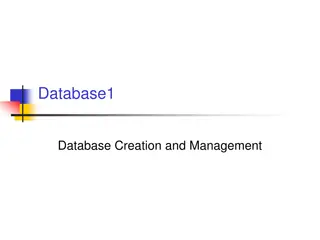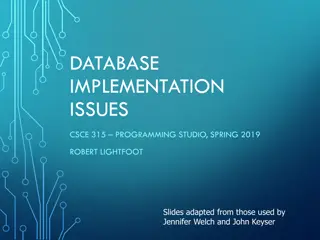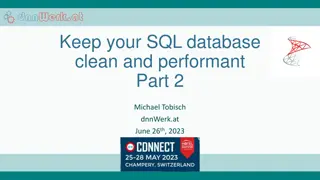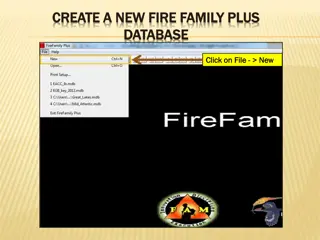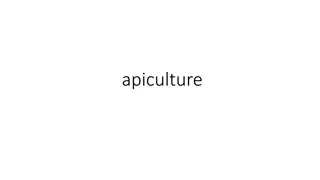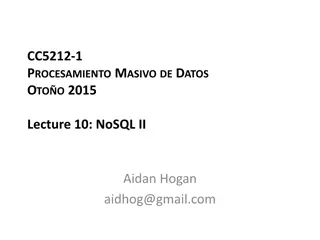A NoSQL Database - Hive
Hive is a data warehousing framework built on top of Hadoop by Facebook to analyze large volumes of daily data traffic. It is used for producing reports, performing backend processing, quantifying campaign success, and maintaining website integrity. HiveQL, Hive's SQL dialect, supports various datatypes. Hue is an open-source user-friendly web interface for Hadoop components. Loading data into HDFS involves moving datasets needed for tables into HDFS.
Download Presentation

Please find below an Image/Link to download the presentation.
The content on the website is provided AS IS for your information and personal use only. It may not be sold, licensed, or shared on other websites without obtaining consent from the author.If you encounter any issues during the download, it is possible that the publisher has removed the file from their server.
You are allowed to download the files provided on this website for personal or commercial use, subject to the condition that they are used lawfully. All files are the property of their respective owners.
The content on the website is provided AS IS for your information and personal use only. It may not be sold, licensed, or shared on other websites without obtaining consent from the author.
E N D
Presentation Transcript
A NoSQL Database - Hive Dania Abed Rabbou
Hive A data-warehousing framework built on top of Hadoop by Facebook Grew from a need to analyze huge volumes of daily data traffic (~10 TB) generated by Facebook Facebook owns the second largest Hadoop cluster in the world (~2 PB)
Hadoop & Hive Usage at Facebook To produce daily and hourly summaries such as reports on the growth of users, page views, average time spend on different pages etc. To perform backend processing for site features such as people you may like and applications you may like. To quantify the success of advertisement campaigns and products. To maintain the integrity of the website and detect suspicious activity.
Hive vs. RDBMs 1. Schema on read: 2. Updates: Traditionally the table s schema is enforced at data load time (schema on write). Hive enforces it at query time (a load operation is simply a quick file move) Table updates are only possible by transforming all the data into a new table (i.e. no appends) 3. Transactions : 4. Indexes: Hive does not support concurrent accesses to tables and hence application-level concurrency and locking mechanisms are needed. Support provided but relatively immature
HiveQL: Hives SQL Dialect HiveQL adopts a SQL-like syntax HiveQL supports the following datatypes: Primitive: Complex: TINYINT (1 byte), SMALLINT (2 bytes), INT (4 bytes), BIGINT (8 bytes), DOUBLE, BOOLEAN, STRING ARRAY, MAP, STRUCT Eg: CREATE TABLE tbl ( col1 ARRAY<INT>, col2 MAP<STRING, INT>, col3 STRUCT<a:STRING, b:INT, c:DOUBLE> );
Hue: Hadoops Web Interface Hue is an open-source user-friendly web-interface for Hadoop components (including HDFS, Hive, Pig, etc.) Browse to your Hue interface located at: <andrew_id>-hdp.qatar.cmu.local:8000 username: hue password: SummerYet
Loading Data into HDFS Any datasets needed for loading into tables must be moved to HDFS Load some test datasets into HDFS: Navigate to the File Browser Create a new directory, say DatasetsSource Move into DatasetsSource and upload three csv files namely customer_details, recharge_details, and customer_details_with_addresses
Creating Databases To create a new Hive database: Browse to Beewax (Hive s UI) Click on the Databases tab Create a new database, say Customers
Creating Tables Create two tables under the database Customers: In Beewax, click on the Query Editor tab Create tables customer_details & recharge_details CREATE TABLE IF NOT EXISTS customer_details (phone_num STRING, plan STRING, date STRING, status STRING, balance STRING, region STRING) COMMENT "Customer Details" ROW FORMAT DELIMITED FIELDS TERMINATED BY "," STORED AS TEXTFILE; CREATE TABLE IF NOT EXISTS recharge_details (phone_num STRING, date STRING, channel STRING, plan STRING, amount STRING) COMMENT "Recharge Details" ROW FORMAT DELIMITED FIELDS TERMINATED BY "," STORED AS TEXTFILE;
Loading Data from HDFS to Tables Load data into the two tables: In the Query Editor tab, load each dataset previously uploaded to HDFS into its respective table LOAD DATA INPATH "/user/hue/DatasetsSource/customer_details.csv" OVERWRITE INTO TABLE customer_details; LOAD DATA INPATH "/user/hue/DatasetsSource/recharge_details.csv" OVERWRITE INTO TABLE recharge_details; Browse back to /user/hue/DatasetsSource; the datasets loaded into tables disappeared!! Hive moves the datasets to a default warehousing folder
Deleting Tables To delete a table: In the Tables tab, choose a table to delete and click drop The table including its metadata and data is deleted! In other words, the loaded data no longer exists anywhere!
Creating External Tables To control the creation and deletion of data, use external tables CREATE EXTERNAL TABLE IF NOT EXISTS customer_details (phone_num STRING, plan STRING, date STRING, status STRING, balance STRING, region STRING) COMMENT "Customer Details" ROW FORMAT DELIMITED FIELDS TERMINATED BY "," STORED AS TEXTFILE LOCATION "/user/hue/LoadedDatasets"; A path were the loaded dataset will be stored. If the table is deleted, the data stays around
Displaying Data in Tables Consider the schemas of our two tables: customer_details(phone_num, plan, date, status, balance, region) recharge_details(phone_num, date, channel, plan, amount) Display the records in customer_details SQL: SELECT * FROM customer_details; HiveQL: SELECT * FROM customer_details;
Updating Tables Consider the schemas of our two tables: customer_details(phone_num, plan, date, status, balance, region) recharge_details(phone_num, date, channel, plan, amount) Let s update plan 4060 to a recharge amount of 500 SQL: UPDATE recharge_details SET amount=500 WHERE plan=4060; The entire table contents is re- written HiveQL: INSERT OVERWRITE TABLE recharge_details SELECT phone_num, date, channel, plan, CASE WHEN plan=4060 THEN 500 ELSE amount END as amount FROM recharge_details;
Joining Tables Consider the schemas of our two tables: customer_details(phone_num, plan, date, status, balance, region) recharge_details(phone_num, date, channel, plan, amount) Let s display the recharge amount per customer SQL: SELECT c.phone_num, r.amount FROM customers_details c, recharge_details r WHERE c.phone_num = r.phone_num; HiveQL: SELECT customer_details.phone_num, recharge_details.amount FROM customer_details JOIN recharge_details ON (customer_details.phone_num = recharge_details.phone_num);
Tables with Complex Datatypes Let's add a new field to the customer_details table called "addresses". This field shall hold a list of addresses per customer CREATE TABLE IF NOT EXISTS customer_details_2 (phone_num STRING, plan STRING, date STRING, status STRING, balance STRING, region STRING addresses ARRAY<STRING>) COMMENT "Customer Details" ROW FORMAT DELIMITED FIELDS TERMINATED BY "," COLLECTION ITEMS TERMINATED BY ;" STORED AS TEXTFILE; LOAD DATA INPATH "/user/hue/DatasetsSource/ customer_details_with_addresses.csv" OVERWRITE INTO TABLE customer_details_2; SELECT * FROM customer_details_2; SELECT addresses[0] FROM customer_details_2;
Built-In Functions Hive provides many built-in functions. To list them all: SHOW FUNCTIONS; To understand the functionality of a function: DESCRIBE FUNCTION array_contains; Let s display those customer records whose addresses include Qatar SELECT * FROM customer_details_2 WHERE array_contains(addresses, "Oman");
Hives Additional Features Allows User-Defined Functions (UDFs). UDFs can be written in Java and integrated with Hive. Support a new construct (TRANSFORM .. USING ..) to invoke an external script or program. Hive ships invokes the specified program, feeds it data, and reads data back. Useful for pre-processing datasets before loading them into tables etc.
